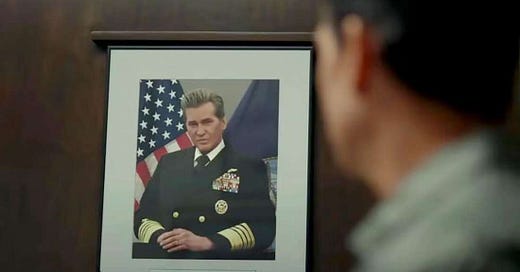On May 5, 2022, I attended a press screening for Top Gun: Maverick in Vienna, ahead of the movie’s international premiere at the Cannes Film Festival. Also present was my partner at the time, a fellow film journalist, with whom I discussed the merits of the original Top Gun while we were waiting for the sequel to start. We both agreed it was fun but not that special. Or, to paraphrase my friend Luca Liguori when he talks about the first Jurassic Park, its cultural importance supersedes its artistic achievements.
Then Maverick began, and I found myself surprisingly riveted by the almost shot-for-shot recreation of the original opening credits. By the time Kenny Loggins started singing Danger Zone, I was already fully on board. Between June and December of that year, I saw the film another four times in the cinema (the last of them on a whim because it was a special IMAX screening with discounted tickets). I still rewatch it once a year.
While the spectacle was undoubtedly a factor, as was the symbolism of Tom Cruise, like Maverick, proving he still mattered in a world where the human element is increasingly devalued, there was one thing in particular that kept inviting me back to see the movie: the quieter, character-based moments, which felt of a piece with the action whereas in 1986 they came across as a distraction while waiting for the next brilliant Tony Scott set piece.
One moment stood out, one that people discovered in theaters because Paramount knew better than to even hint at it in the trailers: the reunion between Pete “Maverick” Mitchell and his erstwhile rival, now close friend, Tom “Iceman” Kazansky. For the entire first half of the movie, Kazansky is an unseen character, who communicates with his buddy via text. They eventually meet in person when Maverick most desperately needs spiritual guidance, due to the past impacting his present decision-making.
It's the most important scene in the film, for various reasons, not least the fact it’s the only interaction between Cruise and Val Kilmer, the sole other original cast member to return for the sequel outside of archive footage. Kilmer had famously been on the fence about portraying Iceman back in 1986, as he wasn’t too crazy about the script, but ended up doing it anyway due to a multiple-picture deal Paramount asked him to honor. The end result clearly pleased him, as he openly lobbied to return once Maverick was officially announced, and Cruise was adamant his former co-star had to appear in some capacity.
To what extent he would play a part in the sequel was largely dictated by real-world circumstances, which were adapted as part of Iceman’s characterization: in 2017, it was revealed the actor had undergone treatment for throat cancer, which severely impaired his speaking ability (his dialogue in The Snowman, released the same year, was entirely – and visibly – dubbed in post-production, with questionable results).
He was gradually recovering to the point of hopefully resuming his career in full, but for the purposes of Iceman’s return, his active involvement consisted of a single scene (for the Disney+ Willow series, also released in 2022, Lucasfilm hired his son Jack to serve as a soundalike for a voice-only cameo, with the option of a full-fledged return as Madmartigan in a second season that never got made). Like Kilmer himself, Kazansky is shown to be mostly non-verbal due to health issues, and he conveys his advice via a computer screen: “It’s time to let go.”
When Maverick still hesitates as to what to do with the mission and the students assigned to him, Iceman stands up and addresses him with a weakened, but determined voice. And once the pep talk is over, there’s still room for a little friendly ribbing: “One last thing: who’s the better pilot, you or me?” Maverick responds, “This is a nice moment, let’s not ruin it”, before continuing the hug that shows how much their bond has deepened since their testosterone-fueled rivalry almost four decades prior.
It was initially reported, based on previous articles about Kilmer’s collaboration with the software company Sonantic to digitally recreate his voice, that some version of this technology had been used for the scene. This turned out to be inaccurate, as director Joseph Kosinski clarified that while some post-production tinkering was required to increase the audio’s clarity, the performance was 100% Kilmer, unaided by artificial reconstructions. And while it was not intended to be his final acting role, it’s quite fitting as a swansong for an actor who, after a tumultuous life and career (including a not entirely unearned reputation for being difficult to work with), made one last comeback as a character who no longer let the past consume him. It was time to let go.
As they’re hugging at the end of the scene, Maverick, perhaps knowing this is the last time he’ll ever see his friend, says, “Thank you, Ice. For everything.” Three years later, that line doubles as everyone’s expression of gratitude towards Kilmer, a far better actor than Marlon Brando infamously gave him credit for, with so many possibilities that will remain unexplored due to his untimely departure to the ultimate Danger Zone.




